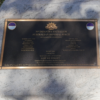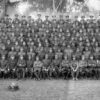The memorial to the fiftieth Infantry Battalion of the Australian army (AIF) was dedicated on 13 August 2013 at 11am on the Pathway of Honour, Adelaide. This date was specifically chosen at it coincides with the 97th anniversary of the Battle of Mouquet Farm during the re-capture of Pozieres and was the first major conflict for this Battalion. The memorial was unveiled by Lieutenant Governor Kevin Scarce with relatives of the battalion soldiers present.
The memorial plaque reads:
50th Infantry Battalion
Australian Imperial ForceBattle and Theatre Honours
Somme 1916-1918 Ancre, 1918
Pozieres Viller-Bretonneux
Bullecourt Hamel
Messines, 1917 Amiens
Ypres, 1917 Albert 1918
Menin Road Hindenburg Line
Polygon Wood Epehy
Passchendaele France and Flanders, 1916-18
Egypt 1916Casualties: 720 Killed and 1,557 Wounded
LEST WE FORGET
Unveiled by His Excellency
Mr Hieu Van Le AO
The Governor’s Deputy of South Australia
On the 13th Of August 2013; The 97th Anniversary of the Battalion’s First Major Battle at Mouquet Farm during the Battle for Pozieres in 1916.
‘Hurcombe’s Hungry Half Hundred’
The 50th Infantry Battalion was formed in February 1916 during the First World War. The Battalion was uniquely formed in Egypt as part of the army’s ‘doubling’ practice and was therefore comprised of almost half new recruits and half ‘bloodied’ soldiers previously from the 10th. The 50th also reflected the previous composition of the 10th battalion by being comprised mainly of South Australian soldiers. Its pseudonym as ‘Hurcombe’s Hungry Half Hundred’ was comprised of the numerical title of the battalion and the name of its first commanding officer, Lieutenant Colonel Frederick Hurcombe.
Shortly after their formation in Egypt, the Battalion was sent to France to assist with the European conflict on the Western Front. After arriving on the 11 June 1916, the 50th Battalion became involved in the Battle of the Somme and saw heavy casualties when engaging the enemy at Mouquet Farm two months later. After two assaults on the enemy forces between August and September, the battalion’s maintained their position and alternated their duties between labouring and maintaining the front-line.
Once the German army began to retreat to the Hindenburg Line in early 1917, the 50th once again engaged with the enemy during the 2 April Attack on Noreuil. With the tides turning, the Australian Infantry Forces moved their operations to Ypres, Belgium where the 50th played an active part in the Battle of Messines and the Battle of Polygon Wood. While the Western Front started to repel the enemy back, the loss of Russian forces when they left the conflict in October 1917 gave the German Army the opportunity to redirect their Eastern efforts back to the Western Front. To combat this new push from the German Army, the 50th Battalion (alongside the rest of the 4th Division) was deployed to defend positions around the River Ancre in France. While there the battalion assisted in combatting the German attack at Dernancourt and helped dislodge the enemy from the French town of Villers-Bretonneux. For the last few months of the war, the 50th Battalion continued to assist in the Allies’ offensive tactics including the attack on the Hindenburg “outpost line”.
During their service, ‘Hurcombe’s Hungry Half Hundred’ took part in some of the largest and important conflicts coordinated by the Australian Army. While the battalion was recognised for their resilience and bravery in combat, the actions of Private Jorgen Jensen in particular was recognised by an awarding of the Victoria Cross. During the attack of Noreuil, Private Jensen single-handedly rushed an enemy machine gun nest and theatened the enemy with a bomb. Once inticing their surrender, he then sent a prisoner to order another neighbouring unit to surrender as well. After the armistace, the Australian Army decided to cease the existance of the 50th Battalion and combines their forces into the 51st.






Comments